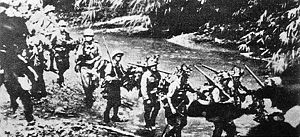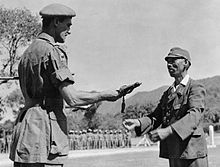31st Division (Japanese Empire)
|
31st division |
|
|---|---|
 Soldiers of the 31st Division during Operation U-gō , March 1944 |
|
| active | May 22, 1943 to 1945 |
| Country |
|
| Armed forces |
|
| Armed forces |
|
| Branch of service | infantry |
| Type | division |
| Strength | approx. 20,000 |
| Insinuation | 15th Army |
| Location | Bangkok |
| Nickname | Retsu-heidan ( 烈 兵 団 , "Eager Division") |
| Butcher | Pacific War |
The 31st Division ( Japanese 第 31 師 団 , Dai-sanjūichi Shidan ) was a division of the Imperial Japanese Army , which was established in 1943 and dissolved in 1945. She was instrumental in the Battle of Kohima during the Japanese Operation U-gō . Your Tsūshōgō code (military code name) was Eifrig-Division ( 烈 兵 団 , Retsu-heidan ) or Retsu 10701 or Retsu 10720 .
History of unity
The 31st Division was set up on May 14, 1943 under the command of Lieutenant General Satō Kōtoku as a Type B "standard" division as a Triangular Division and was under the 15th Army . It consisted of 31 infantry - brigade (58th, 124th and 138th Infantry Regiment ) and 31 reconnaissance regiment, 31 field artillery regiment and 31 pioneer - and transport regiment. The 31st Division was thus put together from existing regiments that had become free through the conversion from Square to Triangular Division. So the 58th Infantry Regiment came from the 13th , the 124th Infantry Regiment from the 18th and the 138th Infantry Regiment from the 116th Division . The headquarters of the roughly 20,000-strong division was in Bangkok . The remaining troops were made up of freshly recruited recruits.
At the end of 1943, the commander of the 15th Army, Lieutenant General Mutaguchi Renya , had plans to invade India from Burma. Ultimately, Mutaguchi's superior, General Kawabe Masakazu , commander of the Burma Regional Army , gave his approval. The company was christened Operation U-gō and provided that the 33rd and 55th Divisions should attack, besiege and take Imphal , while the 31st Division had Kohima as a target. Kohima was an important supply post for Imphal for the Allies and taking the former would drastically increase the chances of success.
On March 15, 1944, Satō and his division, which at that time numbered about 15,000 men, set out on the more than 100 km long route across the jungle of Burma. All loads, weapons, food and ammunition had to be transported by his men or beasts of burden. For the duration of the operation, a steady flow of supplies, as is usual, was not provided and left the company on thin stilts. Satō was a determined and aggressive commander and thus predestined for this task, but had been against Mutaguchi's plan not only for logical reasons, but also for personal reasons. He had long been a bitter political opponent of Mutaguchi and expressed this at every opportunity.
On March 19, the advance guard of the 31st Division surprised and drove the 50th Indian Paratroop Brigade stationed at Sheldon's Corner . Alerted by the appearance of strong Japanese forces, the Allied troops at Kohima were reinforced by air transport by the 161st Indian Brigade of the 5th Indian Division . On March 22nd, the 31st Division had made its way to Sangshak and attacked the withdrawn remnants of the 50th Paratrooper Brigade in several waves of attack.
On April 4, the first troops of the 31st Division, exhausted by marching and fighting, reached Kohima. The British and Indian troops expanded their positions with bunkers and trenches near Kohima, which lies on a ridge. The Japanese immediately began bombarding the Allied positions with their Type 94 75 mm mountain guns. By April 17, the 31st Division was able to tighten the ring around Kohima, whereby the overall shortage of supplies, but especially for artillery shells , became more and more serious. The flagging Japanese attack made it possible for the British to bring supplies and relief to Kohima on April 18 for the first time since the attacks began - including some Lee Grant tanks . On April 20, the British 2nd Infantry Division arrived and let the number of defenders increase again. In view of the renewed Allied reinforcement, Lieutenant General Satō saw himself compelled to complain to the headquarters of the 15th Army about a lack of supplies.
On April 23, Satō ordered in a last-ditch effort to take Kohima, but it failed. Then the 31st division went on the defensive. With the help of the tanks, the Allies then went on the offensive and gradually cleared the Japanese bunkers. On May 25, after two months of uninterrupted fighting and virtually no supply, Satō radioed Mutaguchi for permission to withdraw, which he did not, however, grant him. Six days later, Satō sent the following radio message to Mutaguchi:
「善 戦 敢 闘 六十 日 に お よ び 人間 に 許 さ れ た る 最大 の 忍耐 を 経 て し か も 刀 折 れ 矢 尽 き た り. い ず れ の 日 に か 再 び 来 た っ て 英 霊 に 託 び ん. こ れ を 見 て 泣 か ざ る も の は 人 に あ ら ず。 」
“We fought with the greatest bravery for over two months and reached the limits of human strength. Our swords are broken and the arrows fired. We withdraw from Kohima, crying bitter tears. "
On May 31, Satō withdrew his division, which had shrunk to approx. 8,000 men, on his own responsibility from Kohima and went on retreat. Satō's insubordination had consequences and led to his recall. On July 5, 1944, he was replaced by Lieutenant General Kawada Tsuchitarō .
The remnants of the 31st Division withdrew to Burma, leaving behind all their equipment.
The division was officially dissolved in September 1945.

structure
In March 1943 the formation of a type B "Standard" division took place as follows:
- 31st Infantry Division Staff (75 men)
- 31st Infantry Brigade Staff (100 men)
- 58th Infantry Regiment (3845 men)
- 124th Infantry Regiment (3845 men)
- 138th Infantry Regiment (3845 men)
- 31st Field Artillery Regiment (approx. 3400 men) 1
- 31st Reconnaissance Regiment (approx. 440 men)
- 31. Signal unit (approx. 250)
- 31st Pioneer Regiment (800 men)
- 31st Transport Regiment (1700 men)
- 31. Field hospital (4 × 250 men)
- 31. Medical unit (approx. 900 men)
- 31. Water supply and treatment unit (200 men)
- 31. Veterinary hospital (50 men)
- 31st Supply Company (50 men)
- 31st Infantry Brigade Staff (100 men)
Total strength: approx.20,720 men
guide
Division commanders
- Satō Kōtoku, Lieutenant General: March 25, 1943 - July 5, 1944
- Kawada Tsuchitarō, Lieutenant General: July 5, 1944 - September 1945
See also
Web links
- HyperWar: Leyte Campaign on Ibiblio.org. Ibiblio.org, accessed June 22, 2015 .
literature
- Victor Madej: Japanese Armed Forces Order of Battle, 1937-1945. Game Publishing, 1981, OCLC 833591372 , OCLC 833591376 .
- John Underwood: The Japanese Order of Battle in World War II, Vol I The Nafziger Collection, Inc., 1999, ISBN 978-1-58545-044-2
- Leland Ness: Rikugun: Guide to Japanese Ground Forces 1937-1945. Helion & Company, 2014, ISBN 978-1-909982-00-0 .
- Samuel E. Morison: History of United States Naval Operations in World War II. Vol. 12: Leyte, June 1944-January 1945 University of Illinois Press, 2002 ISBN 0-252-07063-1
- Robert Lyman: Kohima 1944 Osprey Publishing, 2010 ISBN 978-1-84603-939-3

